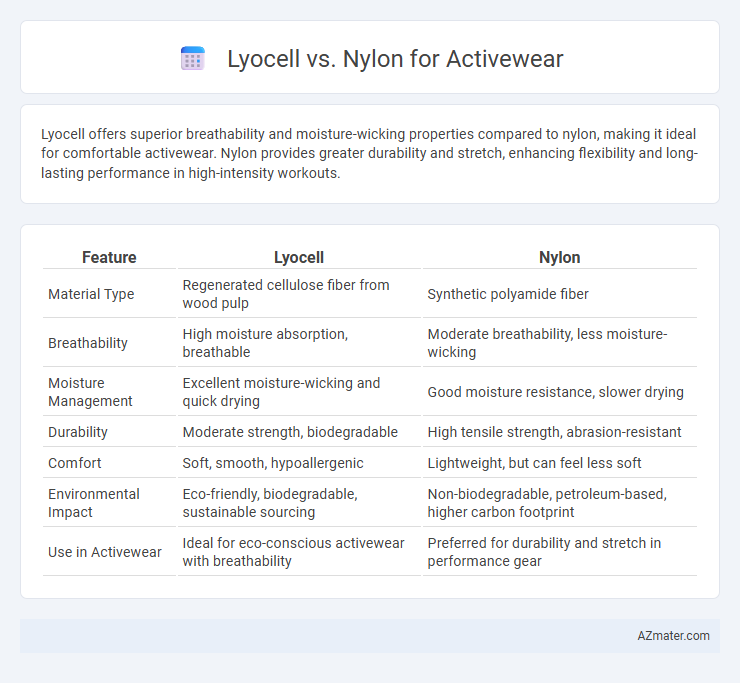Lyocell offers superior breathability and moisture-wicking properties compared to nylon, making it ideal for comfortable activewear. Nylon provides greater durability and stretch, enhancing flexibility and long-lasting performance in high-intensity workouts.
Table of Comparison
| Feature | Lyocell | Nylon |
|---|---|---|
| Material Type | Regenerated cellulose fiber from wood pulp | Synthetic polyamide fiber |
| Breathability | High moisture absorption, breathable | Moderate breathability, less moisture-wicking |
| Moisture Management | Excellent moisture-wicking and quick drying | Good moisture resistance, slower drying |
| Durability | Moderate strength, biodegradable | High tensile strength, abrasion-resistant |
| Comfort | Soft, smooth, hypoallergenic | Lightweight, but can feel less soft |
| Environmental Impact | Eco-friendly, biodegradable, sustainable sourcing | Non-biodegradable, petroleum-based, higher carbon footprint |
| Use in Activewear | Ideal for eco-conscious activewear with breathability | Preferred for durability and stretch in performance gear |
Introduction: Lyocell vs Nylon in Activewear
Lyocell offers superior moisture-wicking and breathability compared to nylon, making it ideal for activewear designed to keep the body cool and dry. Nylon excels in durability and elasticity, providing strong abrasion resistance and stretch essential for high-movement activities. Both fibers contribute distinct performance benefits, with lyocell favoring comfort and sustainability, while nylon supports resilience and shape retention.
Material Overview: What is Lyocell?
Lyocell is a sustainable, biodegradable fiber derived from wood pulp, primarily from eucalyptus trees, known for its exceptional moisture-wicking and breathability properties, making it ideal for activewear. This fiber offers a soft, smooth texture with natural antibacterial qualities, reducing odor buildup during intense workouts. Compared to nylon, Lyocell provides better environmental benefits due to its closed-loop production process that minimizes chemical waste.
Material Overview: What is Nylon?
Nylon is a synthetic polymer known for its exceptional strength, elasticity, and abrasion resistance, making it a popular choice in activewear for durability and shape retention. It is lightweight, moisture-wicking, and quick-drying, which enhances performance during intense physical activities by keeping the wearer dry and comfortable. Nylon's versatility allows it to blend well with other fibers, providing stretch and improved fit in athletic garments.
Moisture-Wicking Capabilities
Lyocell outperforms nylon in moisture-wicking capabilities due to its natural cellulose fibers that absorb and release moisture efficiently, keeping the skin dry and comfortable during intense workouts. Nylon, while durable and quick-drying, tends to trap sweat against the skin, which can lead to discomfort and irritation. Choosing lyocell for activewear prioritizes breathability and moisture management essential for high-performance athletic activities.
Breathability and Comfort
Lyocell offers superior breathability and moisture-wicking capabilities compared to nylon, making it ideal for activewear that requires enhanced airflow and sweat management. The natural fibers in lyocell provide a soft, smooth texture that reduces skin irritation, while nylon's synthetic structure tends to trap heat and moisture, potentially causing discomfort during intense workouts. For comfort-focused activewear, lyocell empowers better temperature regulation and a lightweight feel, whereas nylon emphasizes durability but may compromise breathability.
Durability and Longevity
Lyocell offers moderate durability for activewear with excellent moisture-wicking and breathability but tends to wear faster under intense abrasion compared to Nylon. Nylon excels in durability and longevity due to its high tensile strength, resistance to abrasion, and ability to retain shape over time, making it ideal for high-performance activewear. Combining Lyocell's comfort features with Nylon's durability in blended fabrics balances performance and longevity in activewear garments.
Sustainability and Environmental Impact
Lyocell, derived from sustainably sourced wood pulp, offers superior biodegradability and a closed-loop production process that minimizes water and chemical usage, making it a more eco-friendly choice compared to nylon. Nylon production relies heavily on non-renewable petroleum resources and involves energy-intensive processes that emit significant greenhouse gases and contribute to microplastic pollution. Choosing Lyocell for activewear reduces environmental impact by lowering carbon footprint and enhancing the garment's end-of-life biodegradability.
Performance in Different Weather Conditions
Lyocell offers superior moisture-wicking and breathability, making it ideal for hot and humid weather by keeping the wearer dry and comfortable, while nylon excels in durability and water resistance, providing better protection in wet and cooler conditions. The natural fibers in lyocell enhance temperature regulation and softness against the skin, whereas nylon's synthetic structure ensures quick drying and strong abrasion resistance during intense activities. Performance in varying weather largely depends on the balance between lyocell's comfort and nylon's resilience, influencing fabric choice for activewear based on climate and activity type.
Care and Maintenance Requirements
Lyocell activewear requires gentle care, including cold water washing and air drying to maintain its softness and moisture-wicking properties, avoiding bleach and harsh detergents that can degrade fibers. Nylon activewear demands cautious handling to prevent fabric pilling and loss of elasticity, often requiring low-temperature washing and avoiding fabric softeners to preserve durability and stretch performance. Both fabrics benefit from turning garments inside out before washing to reduce abrasion and prolong the lifespan of activewear.
Which Fabric is Best for Activewear?
Lyocell outperforms nylon in activewear due to its superior breathability, moisture-wicking properties, and eco-friendly production process. Nylon offers durability and stretch, making it suitable for high-impact activities, but it tends to trap heat and moisture, which can reduce comfort during intense workouts. For optimal performance and sustainability, lyocell is the best fabric choice in activewear, providing a balance of comfort, functionality, and environmental benefits.

Infographic: Lyocell vs Nylon for Activewear
 azmater.com
azmater.com